Viola minuscula Greene
Common names:
Northern White Violet, Smooth White Violet
Synonyms:
Viola minuscula Greene, Leafl. bot. observ. 1(4): 247. 1906. TYPE: "This interesting violet has been sent me from western New York, Chatauqua County, by Mr. William B. Limberger, with full notes of its habitat, and characteristics as differing from V. blanda." Type: unknown. [The protologue suggests one collection but makes no mention of a herbarium (although it presumes the collection stayed with Greene, ultimately ending up at NDG). No specimens have been found thus far in a physical search by myself or Barbara Hellenthal at NDG. No types have been located in the JSTOR Global Plants database or in searches of various online regional databases. However, Diane Hurlbut at NYS found a specimen post-dating the publication of the name and sent me images: Randolph, NY, Wm. B. Limberger, May 1907. (William Limberger lived in Ithaca area of New York and botanized in that region, and some of his collections were deposited at NYS). The Limberger sheet is V. minuscula and could serve as a neotype if no earlier original material can be located.]
Viola pallens (Banks ex Ging.) Brainerd var. subreptans J.Rousseau, Naturaliste Canad. 65: 306. 1938
Viola domingensis Urb., Symb. Ant. 7: 287. 1912
Viola pallens (Banks ex Ging.) Brainerd f. alba L.R.Perkins, Rhodora 11: 164. 1909
Viola pallens auct.
Description:
Acaulescent stoloniferous perennials from slender rhizome, colonial from surficial stolons produced in summer, stolons bearing multiple nodes each with a leaf and cleistogamous capsule, ≤ 20 cm tall; foliage and peduncles green, lower surface of leaf blade paler than upper (sometimes drying red- or orange-tinged), glabrous or petioles hirsute; stipules free, finely glandular-fimbriate; leaves spreading, leaf blades undivided, largest ≤ 73 × 56 mm, narrowly to broadly ovate, deltate-ovate, suborbicular or subreniform (very rarely reniform), base shallowly to deeply cordate, lobes roughly parallel to divergent, margins crenate, eciliate, apex abruptly apiculate, obtuse or rounded; chasmogamous peduncle held among or above the leaves; chasmogamous flower ≤ 12 mm; calyx glabrous, eciliate; lowest sepals lanceolate to ovate-lanceolate, obtuse to rounded (rarely acute); auricles short and entire, not elongating in fruit; corolla white, throat greenish-white; spur short-globose; all petals glabrous (lateral petals occasionally with sparse beard of narrowly linear hairs); cleistogamous flowers produced after chasmogamous, on ascending or erect peduncle shorter than or surpassing petioles; capsule 6–7.5 mm, green drying tan, unspotted or with fine red spots, glabrous; seeds 0.8–1.4 × 0.7–0.8 mm, medium to dark olive-brown or brownish-black, with fine black spots; 2n=24.
Similar species:
This species is most similar to other Stolonosae violets with leaf blades nearly as broad as to broader than long. It is distinguishable at any time from V. renifolia by its horizontal stoloniform rhizomes and leafy summer stolons and ascending suborbicular to narrowly ovate glabrous leaf blades, and from V. palustris and V. suecica in its non-creeping rhizome, the leaves terminating the rhizome in a discrete rosette. Its strictly glabrous leaf blades (sometimes with hirtellous petioles) and subentire to very shallowly crenate margins, unspotted cleistogamous capsule on an erect peduncle, and small dark brown to blackish seeds distinguish it from V. blanda and V. incognita.
Ecology:
Saturated peaty, mucky or sphagnous substrates in vernal pools, alder swamps, sedge meadows, seepage areas, fens and bogs (often well out on the bog mat), and marshy edges of streams, rivers and lakeshores.
Distribution:
Transcontinental, NL to NT, south to DE, n. IN, e. IA, MB, along the Appalachian Mountains to n. GA, e. TN, slightly disjunct in e. MO, and south in the Rocky Mountains to n. NM, n. AZ, OR; Dominican Republic (map only showing e. North American range).
Rarity:
State listed in DE [as V. macloskeyi var. pallens], IA [as V. macloskeyi], and MO.
Phenology:
Chasmogamous flower April–July, chasmogamous fruit May, cleistogamous fruit June–September.
Affinities:
This species belongs to the Acaulescent White Violet lineage, sect. Plagiostigma Godron, subsect. Stolonosae (Kupffer.) Kupffer.
Hybrids:
Hybridizes with V. incognita (Scoggan 1978, Ballard 1995), V. lanceolata (Brainerd 1924, Russell 1955c, Boivin 1966, Cinq-Mars 1966, Ballard 1995), V. macloskeyi (Russell 1955c), and V. primulifolia (Dowell 1910, Brainerd 1924, House 1924, Russell 1955c, Harvey Ballard pers. comm.). I have observed many specimens of the hybrids involving V. lanceolata and V. primulifolia and have found the features of chasmogamous flowers and foliage to be more or less precisely intermediate. All hybrids will fail to reproduce by chasmogamous flowers. The interploidal hybrid will likely produce abortive cleistogamous capsules, while the latter two hybrids may produce abortive cleistogamous capsules or normal capsules without viable seeds or a substantially reduced proportion of viable seeds. Studies are needed to confirm these predictions.
Comments:
The protologue suggests one collection but makes no mention of a herbarium. No specimens have been found thus far in a physical search of NDG by myself or Barbara Hellenthal, nor have types been located in the JSTOR Global Plants database or in searches of various online regional databases. However, Diane Hurlbut at NYS found a specimen post-dating the publication of the name: New York, Randolph, W. B. Limberger, May 1907. (William Limberger lived in Ithaca area of New York and botanized in that region, and some of his collections were deposited at NYS). The Limberger sheet is V. minuscula and could serve as a neotype if no earlier original material can be located.
Brainerd (1921b), Brainerd Baird (1942), Fernald (1950), Henry (1953a), Alexander (1963), Strausbaugh and Core (1978), Swink and Wilhelm (1979), Haines et al. (2011), and Ballard (2013) accepted this as a species, V. pallens (Banks ex Ging.) Brainerd, distinct from the far western V. macloskeyi Lloyd. Russell (1955c), Russell (1965), and Ballard (1995, 2000) treated it as a subspecies of V. macloskeyi, while Scoggan (1978), Gleason and Cronquist (1991), and Weakley et al. (2012) treated it as a variety. Voss and Reznicek (2012) accepted it as V. macloskeyi but noted it represented subspecies or variety pallens. McKinney and Russell (2002) and Little and McKinney (2015) synonymized it under V. macloskeyi without recognition of infraspecific taxa. Phylogenetic investigations by Marcussen et al. (2012) placed V. macloskeyi into a “western” clade separate from the present taxon, indicating that the two must be treated as separate species. Recent scrutiny of the lectotype of V. rotundifolia Michx. var. pallens Banks ex Ging. disclosed the creeping rhizomes with separate leaf insertions and broadly reniform leaf blades characteristic of V. epipsila subsp. repens (corroborated by an annotation to that effect by Wilhelm Becker), removing the name from consideration. The next available name, V. minuscula Greene, with original material and protologue description precisely matching this taxon, is used here. Western North American populations are tentatively included here but are not typical and require reexamination. Ballard et al. (2001) demonstrated that Dominican Republic specimens, formerly treated as V. domingensis Urban, are morphologically indistinguishable from the present species and thus evidently represent an early Antillean dispersal event from eastern North America. Although frequently confused with V. blanda and V. incognita with which it sometimes grows, it is easily distinguished from those species in chasmogamous flower by its strictly glabrous suborbicular to ovate leaf blades (although the petioles are often hirtellous) with very shallow marginal crenations and its glabrous or very sparsely bearded lateral petals, and in cleistogamous fruit by its green unspotted cleistogamous capsules on erect peduncles and its smaller olive-brown finely spotted seeds.
Literature Cited:
Alexander, E. J. 1963. Violaceae. In Gleason, H. A., The new Britton and Brown illustrated flora of the northeastern United States and adjacent Canada. Hafner Publishing Co., Inc., New York, NY. 552-567.
Ballard Jr., H. E. 1995 ["1994"]. Violets of Michigan. Michigan Botanist 33: 131-199.
Ballard Jr., H. E. 2000. Violaceae. In Rhoads, A. (ed.). Flora of Pennsylvania. University of Pennsylvania Press, Philadelphia, PA. 700-710.
Ballard Jr., H. E. 2013. Violaceae. In Yatskievych, G., Flora of Missouri. Missouri Botanical Garden Press, St. Louis, MO. 1218-1243.
Ballard Jr., H. E., D. A. Casamatta, M. M. Hall, R. A. McCauley, M. C. Segovia-Salcedo, and R. G. Verb. 2001. Phenetic analysis shows conspecificity between Hispaniolan Viola domingensis Urban and North American Viola macloskeyi sensu lato (Violaceae). Brittonia 53: 122-136.
Boivin, J. R. B. 1966. Enumération des plantes du Canada. Le Naturaliste Canadien 93(5): 583-646.
Brainerd, E. 1921b. Violets of North America. Vermont Agricultural Experiment Station Bulletin 224: 1-172.
Brainerd, E. 1924. The natural violet hybrids of North America. Vermont Agricultural Experiment Station Bulletin 239.
Brainerd Baird, V. 1942. Wild violets of North America. University of California Press, Berkeley, CA.
Cinq-Mars, L. 1966. Mise au point sur les violettes (Viola spp.) du Québec. Naturaliste canadien 93: 895–958
Dowell, P. 1910. The violets of Staten Island. Bulletin of the Torrey Botanical Club 37: 163-179.
Fernald, M. L. 1950. Violaceae. In Gray’s Manual of Botany, 8th ed. American Book Company, New York, NY. 1022-1042.
Gleason, H. A., and A. Cronquist. 1991. Violaceae. In Manual of vascular plants of northeastern United States and adjacent Canada, 2nd ed. New York Botanical Garden, Bronx, NY. 157-163.
Haines, A., E. Farnsworth, and G. Morrison. 2011. Violaceae. In Flora Novae Angliae. Yale University Press, New Haven, CT. 873-886.
Henry, L. K. 1953a. The Violaceae in western Pennsylvania. Castanea 18(2): 37-59.
House, H. D. 1924. Annotated list of the ferns and flowering plants of New York state. Family 83 Violaceae. New York State Museum Bulletin 254: 499-512.
Little, R. J., and L. E. McKinney. 2015. Violaceae. In Flora of North America: Cucurbitaceae to Droseraceae, 106. Oxford University Press, New York, NY.
Marcussen, T., K. S. Jakobsen, J. Danihelka, H. E. Ballard, K. Blaxland, A. K. Brysting, and B. Oxelman. 2012. Inferring species networks from gene trees in high-polyploid North American and Hawaiian violets (Viola, Violaceae). Systematic Biology 60: 1-20.
McKinney, L. E., and N. H. Russell. 2002. Violaceae of the southeastern United States. Castanea 67: 369-379.
Russell, N. H. 1955c. The taxonomy of the acaulescent white violets. American Midland Naturalist 54: 481-494.
Russell, N. H. 1965. Violets (Viola) of the central and eastern United States: An introductory survey. Sida 2: 1-113.
Scoggan, H. J. 1978. Violaceae. In Flora of Canada, Part 3–Dicotyledoneae (Saururaceae to Violaceae). National Museums of Canada. Ottawa, Canada. 1103-1115.
Strausbaugh, P. D., and E. L. Core. 1978. Violaceae. In Flora of West Virginia, 2nd ed. Seneca Books, Inc., Morgantown, WV. 644-658.
Swink, F., and G. Wilhelm. 1979. Violaceae. In Plants of the Chicago region, 2nd ed. revised and expanded. Morton Arboretum, Lisle, IL. 384, 801-810.
Voss, E. G., and A. A. Reznicek. 2012. Violaceae. In Field manual of Michigan flora. The University of Michigan Press, Ann Arbor, MI. 913-922.
Weakley, A. S., J. C. Ludwig, and J. F. Townsend. 2012. Violaceae. In Flora of Virginia. BRIT Press, Fort Worth, TX. 963-975.
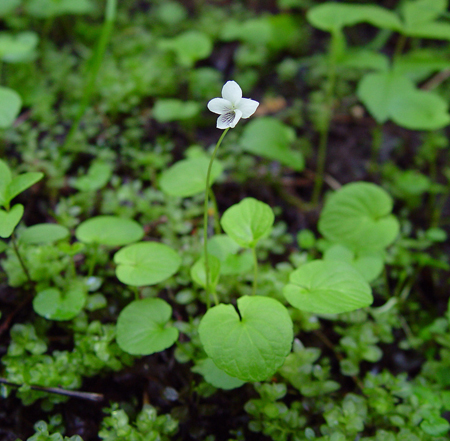
Chasmogamous flowering habit by Arthur Haines, Native Plant Trust
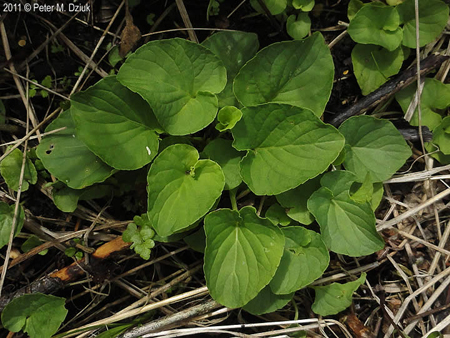
Leaves by Peter M. Dziuk, "Minnesota Wildflowers" website
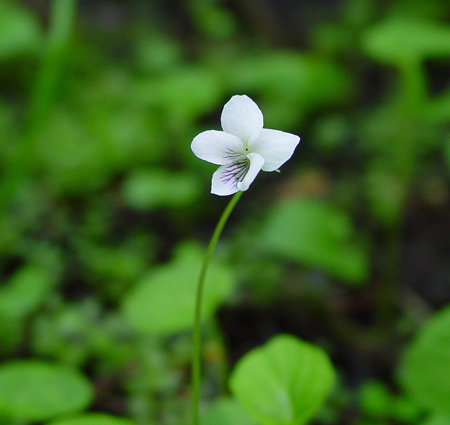
Chasmogamous flower front view by Arthur Haines, Native Plant Trust
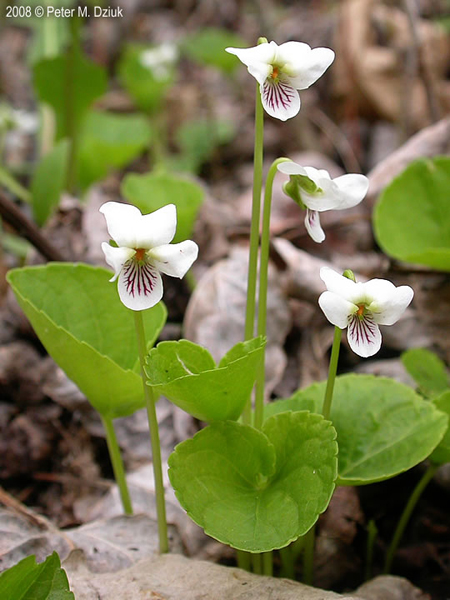
Chasmogamous flower front and profile view by Peter M. Dziuk, "Minnesota Wildflowers" website
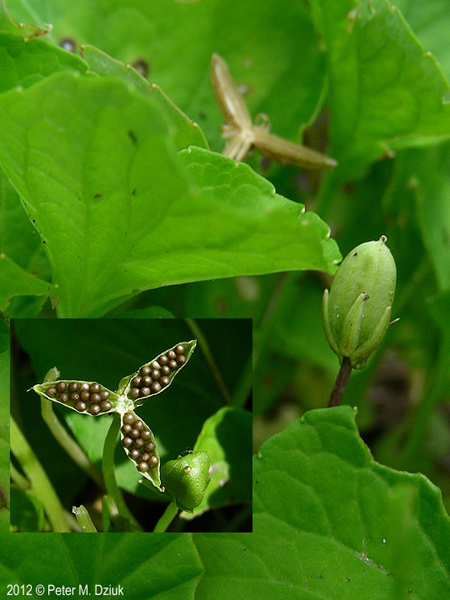
Cleistogamous fruit by Peter M. Dziuk, "Minnesota Wildflowers" website
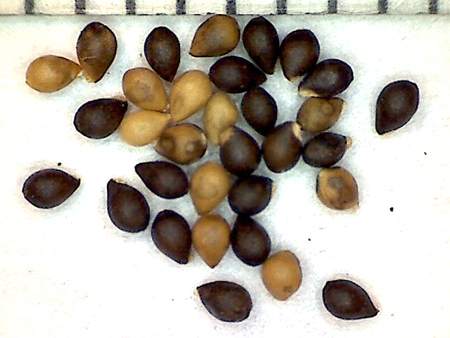
Seeds from herbarium specimen: CT, Franklin, Sphagnum in Smiths Swamp Meadow, 28 Aug 1912, R. W. Woodward s.n. (CBS18248)
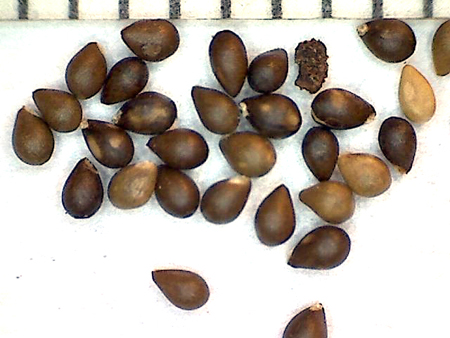
Seeds from herbarium specimen: ME, Seal Harbor, By a woodland stream, 30 Aug 1906, E. L. Shaw s.n. (YU071226)
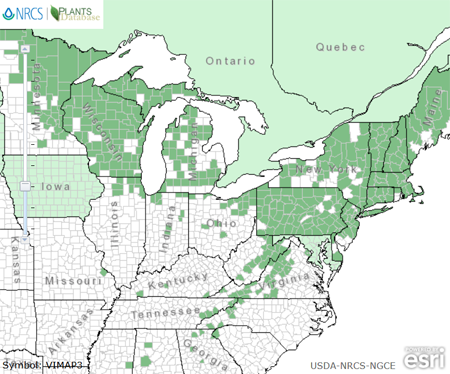
Map of eastern North American portion of range by USDA Plants Database